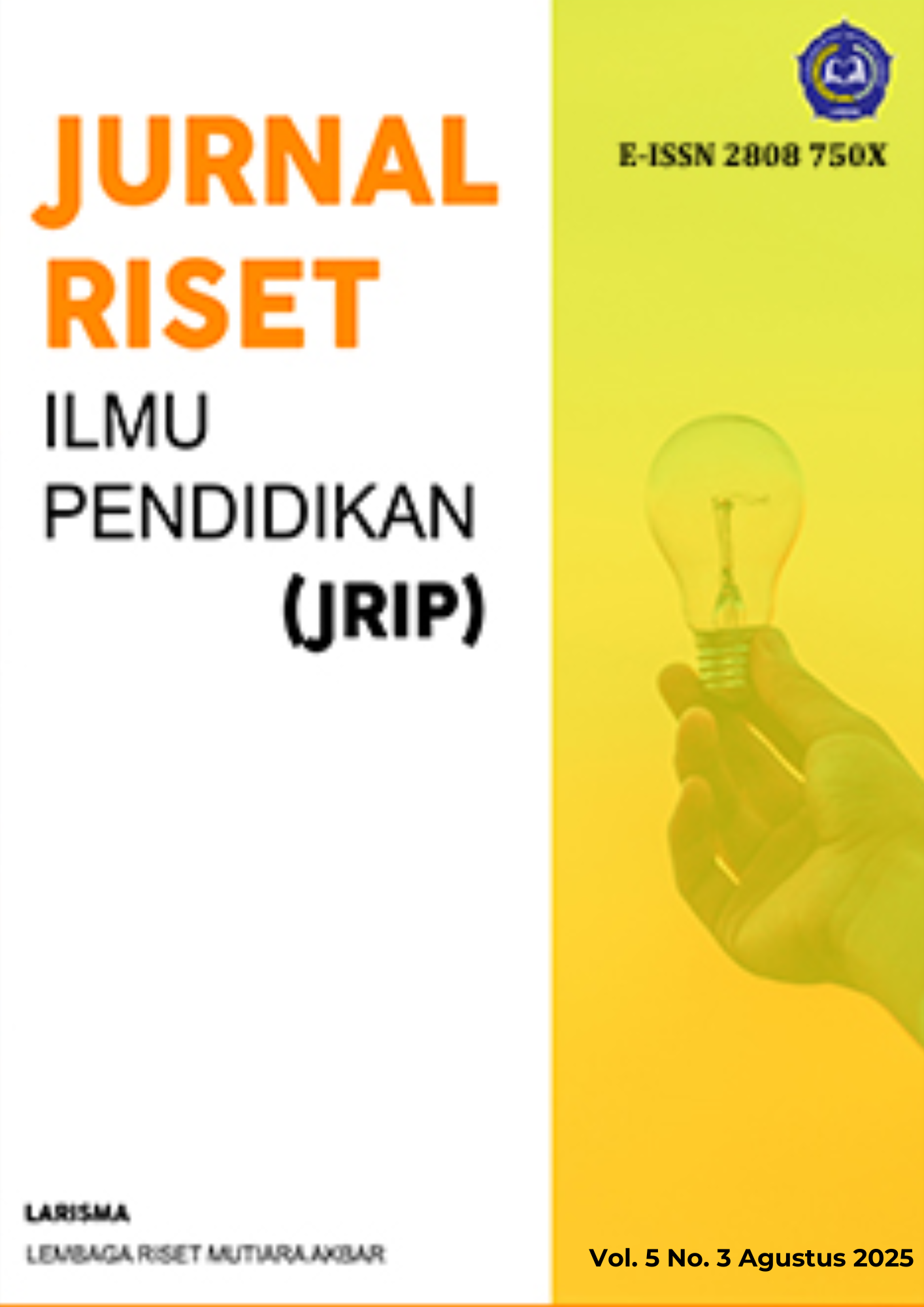The Legacy of Painting Values, Techniques, and Aesthetics through Art Education: A Case Study of Cirebon Glass Painting in the Contemporary Era
Main Article Content
Abstract
Cirebon glass painting is one of the traditional art forms that contains cultural values, distinctive techniques, and local aesthetics. In facing the challenges of modern times, the sustainability of Cirebon glass painting demands a contextual and adaptive inheritance strategy. This study aims to examine how the values, techniques, and aesthetics in the tradition of Cirebon glass painting are passed down through art education, both in the formal (schools and art colleges) and non-formal (studios and communities) realms. Using a qualitative method with an ethnographic case study approach, data was collected through observation, interviews, and visual documentation. The results show that the inheritance of glass painting does not solely depend on technical skills, but also on the internalization of cultural values and understanding of local aesthetics. Art education plays a role as a medium for intergenerational inheritance, although in its implementation it faces various challenges, such as limited curriculum integration, lack of regeneration of artists, and the need for innovative learning methods that are in accordance with the contemporary cultural context. This study recommends strengthening collaboration between educational institutions, traditional art practitioners and communities in designing a sustainable art inheritance model.
Article Details

This work is licensed under a Creative Commons Attribution-ShareAlike 4.0 International License.
References
Akkapurlaura, A. (2016). Periodisasi tema lukisan kaca Bambang Sonjaya. Jurnal Dimensi DKV: Seni Rupa dan Desain, 1(2), 151–164. https://doi.org/10.25105/jdd.v1i2.1357
Al-Zadjali, Z. (2024). The significance of art in revealing a culture’s identity and multiculturalism. Open Journal of Social Sciences, 12(1), 232–250. https://doi.org/10.4236/jss.2024.121015
Ananda, N., & Albina, M. (2025). Kajian metode etnografi untuk penelitian di bidang pendidikan. Jurnal Multidisiplin Ilmu Akademik, 2(4), 368–379. https://doi.org/10.61722/jmia.v2i4.5304
Arslanbek, A., Malhotra, B., & Kaimal, G. (2022). Indigenous and traditional arts in art therapy: Value, meaning, and clinical implications. The Arts in Psychotherapy, 77, 101879. https://doi.org/10.1016/j.aip.2021.101879
Assyakurrohim, D., Ikhram, D., Sirodj, R. A., & Afgani, M. W. (2022). Metode studi kasus dalam penelitian kualitatif. Jurnal Pendidikan Sains dan Komputer, 3(1), 1–9. https://doi.org/10.47709/jpsk.v3i01.1951
Bihari, S. (2023). Cultural heritage and indigenous knowledge: Reviving traditions for future generations. Sustainable Development Goals in SAARC Countries: Key Issues, Opportunities and Challenges, 1, 24–32. https://doi.org/10.5281/zenodo.8049777
Casta, C., Rohidi, T. R., Triyanto, T., & Karim, A. (2021). Production of aesthetic tastes and creativity education of Indonesian glass painting artists. Harmonia: Journal of Arts Research and Education, 21(2), 266–277. https://doi.org/10.15294/harmonia.v21i2.30348
Dienaputra, R. D., Yuliawati, S., & Yunaidi, A. (2021). Strategi pengembangan seni lukis kaca di Kecamatan Gegesik Kabupaten Cirebon sebagai atraksi wisata. DHARMAKARYA: Jurnal Aplikasi Ipteks untuk Masyarakat, 10(1), 17–23. https://doi.org/10.24198/dharmakarya.v10i1.30858
Dienaputra, R. D., Yunaidi, A., & Yuliawati, S. (2021). Multikulturalisme kebudayaan daerah Cirebon. Panggung, 31(2), 250–262. https://doi.org/10.26742/panggung.v31i2.1313
Falah, A. M., Cahyana, A., & Gani, S. Z. (2024). Passing down traditions and culture: Methods of painting education at the Jelekong Painting Center, Bandung, Indonesia. ISVS e-journal, 11(2), 92–117. https://doi.org/10.61275/ISVSej-2024-11-02-07
Husnullail, M., & Jailani, M. S. (2024). Teknik pemeriksaan keabsahan data dalam riset ilmiah. Jurnal Genta Mulia, 15(2), 70–78.
Isnanta, S. D. (2014). Penciptaan karya seni lukis kaca dengan teknik layer. Brikolase: Jurnal Kajian Teori, Praktik dan Wacana Seni Budaya Rupa, 6(1), 83–96. https://doi.org/10.33153/bri.v6i1.445
Jailani, M. S., & Husnullail, M. (2024). Metode grounded theory dalam pendekatan praktis. Jurnal Cahaya Mandalika, 5(1), 47–58. https://doi.org/10.36312/jcm.v5i1.2298
Lestari, D., & Paryanto. (2021). Budaya dan heritage Kota Cirebon: Identitas, komersialisasi dan pariwisata. PUSTAKA, 23(2), 84–96.
Raden, A. Z. M., Andrijanto, M. S., & Sukarwo, W. (2019). Figurative calligraphy: Artistic, magic, and religious aspect of the Cirebon glass painting. Cultural Syndrome, 1(1), 1–13. https://doi.org/10.30998/cs.v1i1.17
Ridder, H. G. (2017). The theory contribution of case study research designs. Business Research, 10, 281–305. https://doi.org/10.1007/s40685-017-0045-z
Riswani, R., Efrinon, E., Alfalah, A., Firdaus, F., & Jufri, J. (2023). How local art reveals local genius in the corner of the discourse point of view. Journal of Pragmatics and Discourse Research, 3(1), 103–110. https://doi.org/10.51817/jpdr.v3i1.299
Rukajat, A. (2018). Pendekatan penelitian kualitatif (Qualitative research approach). Deepublish.
Rukiah, Y., Sarwanto, S., Sutarno, S., & Sunardi, S. (2020). Visual elements of Semar calligraphy on Cirebon glass painting of Kusdono’s work. Dewa Ruci: Jurnal Pengkajian dan Penciptaan Seni, 15(2), 71–79. https://doi.org/10.33153/dewaruci.v15i2.3161
Spradley, J. P. (2016). Participant observation. Waveland Press.
Subhaktiyasa, P. G. (2024). Menentukan populasi dan sampel: Pendekatan metodologi penelitian kuantitatif dan kualitatif. Jurnal Ilmiah Profesi Pendidikan, 9(4), 2721–2731. https://doi.org/10.29303/jipp.v9i4.2657
Wijaya, H. (2020). Analisis data kualitatif teori konsep dalam penelitian pendidikan. Sekolah Tinggi Theologia Jaffray.

